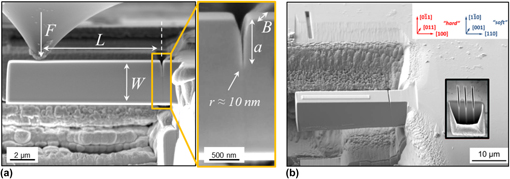Crossref Citations
This article has been cited by the following publications. This list is generated based on data provided by
Crossref.
Nagamani Jaya, Balila
Bhowmick, Sanjit
Asif, S.A. Syed
and
Jayaram, Vikram
2015.
In-situ study of microscale fracture of diffusion aluminide bond coats: Effect of platinum.
Journal of Materials Research,
Vol. 30,
Issue. 21,
p.
3343.
Hintsala, E.
Kiener, D.
Jackson, J.
and
Gerberich, W. W.
2015.
In-Situ Measurements of Free-Standing, Ultra-Thin Film Cracking in Bending.
Experimental Mechanics,
Vol. 55,
Issue. 9,
p.
1681.
Bohnert, C.
Schmitt, N.J.
Weygand, S.M.
Kraft, O.
and
Schwaiger, R.
2016.
Fracture toughness characterization of single-crystalline tungsten using notched micro-cantilever specimens.
International Journal of Plasticity,
Vol. 81,
Issue. ,
p.
1.
Costin, Walter L.
Lavigne, Olivier
Kotousov, Andrei
Ghomashchi, Reza
and
Linton, Valerie
2016.
Investigation of hydrogen assisted cracking in acicular ferrite using site-specific micro-fracture tests.
Materials Science and Engineering: A,
Vol. 651,
Issue. ,
p.
859.
Ast, Johannes
Merle, Benoit
Durst, Karsten
and
Göken, Mathias
2016.
Fracture toughness evaluation of NiAl single crystals by microcantilevers—a new continuous J-integral method.
Journal of Materials Research,
Vol. 31,
Issue. 23,
p.
3786.
Jaya, B. Nagamani
and
Jayaram, Vikram
2016.
Fracture Testing at Small-Length Scales: From Plasticity in Si to Brittleness in Pt.
JOM,
Vol. 68,
Issue. 1,
p.
94.
Costin, Walter L.
Lavigne, Olivier
and
Kotousov, Andrei
2016.
A study on the relationship between microstructure and mechanical properties of acicular ferrite and upper bainite.
Materials Science and Engineering: A,
Vol. 663,
Issue. ,
p.
193.
Treml, R.
Kozic, D.
Schöngrundner, R.
Kolednik, O.
Gänser, H.-P.
Brunner, R.
and
Kiener, D.
2016.
Miniaturized fracture experiments to determine the toughness of individual films in a multilayer system.
Extreme Mechanics Letters,
Vol. 8,
Issue. ,
p.
235.
Gao, Yue
Liu, Zhanli
Zeng, Qinglei
Wang, Tao
Zhuang, Zhuo
and
Hwang, Keh-Chih
2017.
Theoretical and numerical prediction of crack path in the material with anisotropic fracture toughness.
Engineering Fracture Mechanics,
Vol. 180,
Issue. ,
p.
330.
Mueller, Martin Guillermo
Žagar, Goran
and
Mortensen, Andreas
2017.
Stable room-temperature micron-scale crack growth in single-crystalline silicon.
Journal of Materials Research,
Vol. 32,
Issue. 19,
p.
3617.
Eisenhut, Lena
Schaefer, Florian
Gruenewald, Patrick
Weiter, Laura
Marx, Michael
and
Motz, Christian
2017.
Effect of a dislocation pile-up at the neutral axis on trans-crystalline crack growth for micro-bending fatigue.
International Journal of Fatigue,
Vol. 94,
Issue. ,
p.
131.
Ast, Johannes
Göken, Mathias
and
Durst, Karsten
2017.
Size-dependent fracture toughness of tungsten.
Acta Materialia,
Vol. 138,
Issue. ,
p.
198.
Schütze, M.
and
Quadakkers, W. J.
2017.
Future Directions in the Field of High-Temperature Corrosion Research.
Oxidation of Metals,
Vol. 87,
Issue. 5-6,
p.
681.
Snartland, B.D.
Hagen, A.B.
and
Thaulow, C.
2017.
Fracture mechanical testing of single crystal notched α-iron micro-cantilevers.
Engineering Fracture Mechanics,
Vol. 175,
Issue. ,
p.
312.
Ast, Johannes
Mohanty, Gaurav
Guo, Yi
Michler, Johann
and
Maeder, Xavier
2017.
In situ micromechanical testing of tungsten micro-cantilevers using HR-EBSD for the assessment of deformation evolution.
Materials & Design,
Vol. 117,
Issue. ,
p.
265.
Preiß, Eva I.
Merle, Benoit
and
Göken, Mathias
2017.
Understanding the extremely low fracture toughness of freestanding gold thin films by in-situ bulge testing in an AFM.
Materials Science and Engineering: A,
Vol. 691,
Issue. ,
p.
218.
Maňák, Jan
and
Vokoun, David
2018.
Microbending Experiments on Pure Magnesium with Nonbasal Slip Orientation.
Materials,
Vol. 11,
Issue. 8,
p.
1434.
Gruenewald, Patrick
Schaefer, Florian
Thielen, Matthias
Marx, Michael
and
Motz, Christian
2018.
Small scale fracture mechanics of ductile materials: Advantage of fatigue precracks and comparison of J-integral evaluations.
Materialia,
Vol. 4,
Issue. ,
p.
104.
Dehm, G.
Jaya, B.N.
Raghavan, R.
and
Kirchlechner, C.
2018.
Overview on micro- and nanomechanical testing: New insights in interface plasticity and fracture at small length scales.
Acta Materialia,
Vol. 142,
Issue. ,
p.
248.
Snartland, Brage Dahl
Alvaro, Antonio
Osen, Vidar
and
Thaulow, Christian
2018.
Crack arrest testing at the micro-scale.
Engineering Fracture Mechanics,
Vol. 201,
Issue. ,
p.
157.

 $\sqrt {\rm{m}}$ for the soft orientation and around 8.5 MPa
$\sqrt {\rm{m}}$ for the soft orientation and around 8.5 MPa $\sqrt {\rm{m}}$ for the hard orientation, that (ii) there is a strong influence of the anisotropic behavior of NiAl on the fracture toughness values, and that (iii) the J-integral technique is the most accurate quantification method.
$\sqrt {\rm{m}}$ for the hard orientation, that (ii) there is a strong influence of the anisotropic behavior of NiAl on the fracture toughness values, and that (iii) the J-integral technique is the most accurate quantification method.



